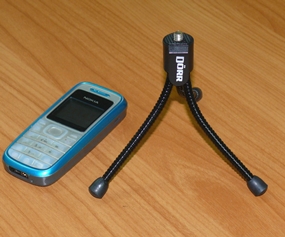As photography for fun begins to open up for you, it will become obvious that you need to expand your kit. However, camera gear of good quality is never cheap, so what are the ‘essentials’ and what can you easily do without?
The first essential is a good digital SLR, from a good manufacturer, and one that takes multiple lenses, from that manufacturer (we can deal with after-market lenses another day). Choose carefully and be prepared to spend upwards of B. 30,000. Ouch!
Handle all the cameras that you think you might like. Some look great, but don’t fit in your hand as well as they might. I was once tempted by a Pentax 6×7 medium format camera, but after one roll of film, I knew it wasn’t for me!
 A mini tripod.
A mini tripod.
When I worked in professional photography I used Nikon in 35 mm – bullet proof and quality lenses. Others such as Canon, Pentax, Olympus, etc., are also excellent brands, all of which have interchangeable lenses too, so your basic system can be enlarged upon over a period of time, and your original lenses will still be good.
The SLR is the center of your equipment. It is this camera that will allow you to be creative aqin your shots. It is this camera that will win you awards and recognition. As mentioned already, it will be expensive, so choose wisely.
Now you look at lenses. The “standard” lens that will come with your SLR will most likely be a 50 mm. The next lens you buy should be a wide angle lens. Around 28 mm or 24 mm is good, or even 20 mm for very dramatic shots, but the distortion problem can be a little much at this wide angle.
The next lens you should buy should be around the focal length of 135 mm – the ideal lens for portraits. The 24 mm gives you the ability to take dramatic photos, the 135 mm allows you to take glamorous portraits.
No zooms? No, I personally do not like zoom lenses. The sharpness is not as good as “prime” lenses (though the manufacturers say they are much better these days), but even more importantly, zoom lenses make for lazy photographers. Instead of walking in to compose the subject, the photographer zooms in. The depth of field is lost, the flash is too far away and the chance of a perfect shot is lost. I realize that the very latest zooms from the parent manufacturer may be excellent, but because of their advanced optics they are very expensive.
You should also have a Point and Shoot compact camera in your camera equipment. Again, stick to the better brands if you want to get something which will last, and even more importantly, one that will return crisp images. Olympus makes some very good small point and shooters, with excellent lenses. This camera is for those situations where you don’t want to lug all the gear, when you need something light and pocket portable. Get one with a 24 or 28 mm lens and built in flash which can be turned off.
The next item is a tripod. Now with all the super-fast ASA ratings available in a D SLR these days, a large Manfrotto, such as I lugged all over the world, is not so necessary. My Manfrotto lives in the cupboard, but a small fold-out tripod lives in my camera bag.
The next items are small and very cheap, but are indispensable. These are stepping rings to bring all your lenses to the same diameter so you can screw filters, etc., on the end, and not duplicate them with different diameters. I have standardized mine on 62 mm. Sometimes this may take two stepping rings coupled together, but just end up with the same diameter on them all.
Now buy a few filters. Look in the catalogue to see what sorts of effects you like – but don’t overdo it! And one you must have is the Skylight 1A you leave permanently on the end of your lens to protect the expensive glass.
The final item is the camera bag. Get a good waterproof one. Tropical storms can come unannounced!




